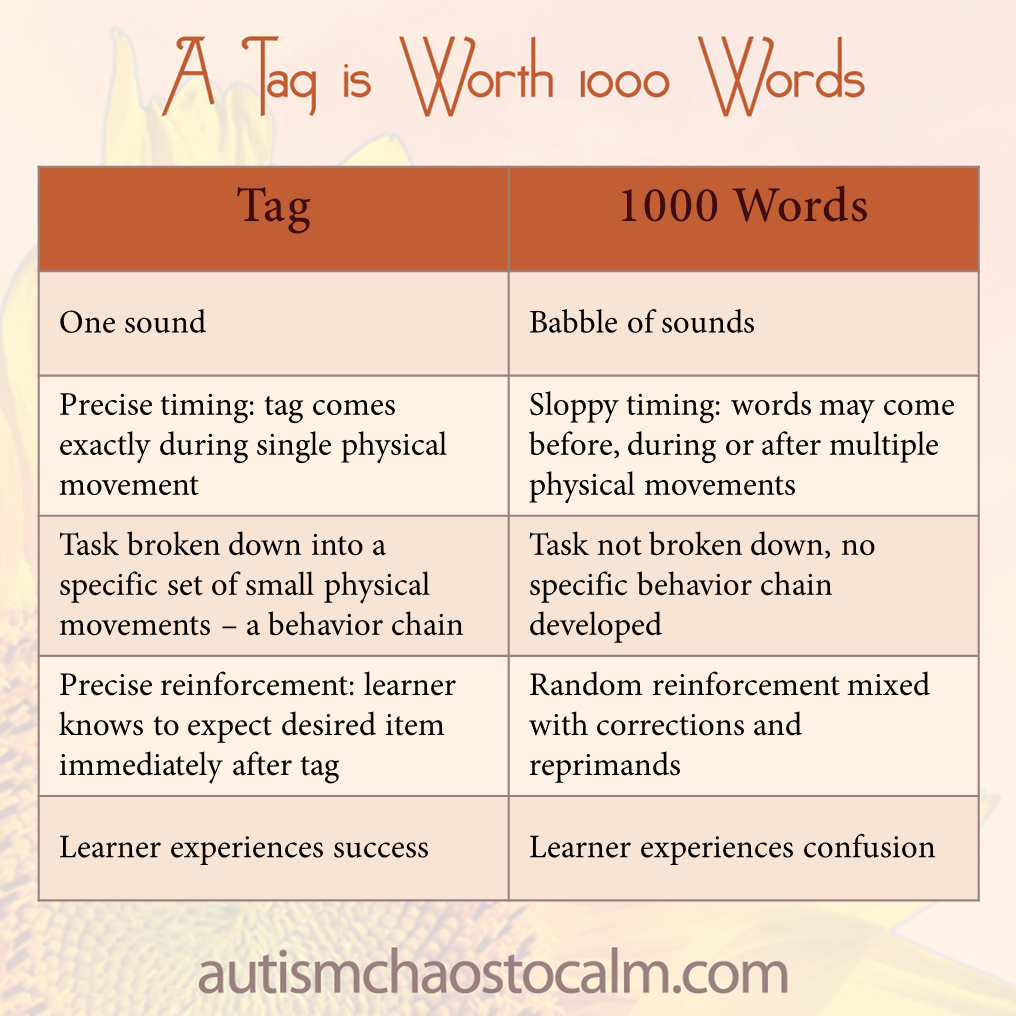Part 3: Precise Reinforcement and Success versus Random Reinforcement and Confusion
In Part 1 of this series, we discussed how the click, or “tag,” is ONE specific sound that relates to ONE specific physical movement. This precise information to the child, “Hey, taking two steps in the same direction is great!” tells him that taking two steps in the same direction is a good thing to do more often. In Part 2, we discussed how the precise timing of the click helps the parent/instructor think about planning the small steps that lead up to the bigger behavior. My goal was to teach Safe Walking, and my son worked up from taking Two Steps/Same Direction, to taking Three Steps/Same Direction, and eventually Walking Beside Me, and Stopping At Corners. For reference, please see the chart I’ve been running in this series of articles.
Benefits of Precise Reinforcement
Part 3 of this series discusses how the precise reinforcement delivers success to the child, and avoids the problems of random reinforcement and confusion. The quick click of the tagger, followed up by a treat (strips of fruit roll-up), gave extraordinarily precise information to my son. The click marked the precise moment his second or third footstep hit the ground in the same direction. If he bolted or spun around, no click and no treat. Being a smart kid who likes fruit roll-ups, he quickly figured out he would get more by taking steps in the same direction.

Problems of Random Reinforcement
Because of the precise, consistent sound of the click and consistent reinforcement for that one targeted behavior, my son knew what to do. There was no confusion because there was no delay in information and reinforcement. Contrast this to what often happens when a child is being urged to walk in a straight line or stay with a group: “Hey Billy, come back here, stay with the group. We’re walking to the playground. Yes, that’s it. You can swing at the playground. No, come this way, we’re going to the left not the right. Just go straight ahead to the swings.” This verbal barrage provides lots of confusing sounds, some instructions, a reprimand, a small amount of praise, and lots of non-pertinent information. Billy experiences too many words, too much emotion, and a lot of confusion and failure. This experience does not build a foundation for continued learning.

Let’s try it with TAGteach
Let’s look at how a different instructor uses a tagger to work with Zack; he starts out by watching Zack’s feet. Zack would experience the following: when he takes Two Steps/Same Direction: he hears a click and gets a tic-tac. Wow! That was easy and he got a nice treat. He takes Two Steps/Same Direction again, and experiences more success and reinforcement. Now he’s got it, he continues taking Two Steps/Same Direction, and before he knows it, he’s standing in front of his favorite swing. Zack experiences success and reinforcement, and really knows to listen for that click—because it means good things are coming. Now the foundation is set for more learning. He’s ready to learn to take Three Steps/Same Direction, then Four Steps/Same Direction, then Walk With Group.
What’s the bottom line?
Precise reinforcement delivers success to the student: he learned something, he did something correctly, and he will do that good thing again. Success breeds success, confidence and attentiveness. Random reinforcement mixed in with confusing instructions, corrections and reprimands delivers confusion and failure to the student. Which student do you think is experiencing success and confidence, Billy or Zack?
What is TAGteach?
TAGteach stands for Teaching with Acoustical Guidance. TAGteach is a teaching and communication method based on the scientific principles of Applied Behavior Analysis (ABA).
TAGteach enables extremely precise positive reinforcement of behavior by using an acoustical signal to “mark” the behavior – at the precise moment the child performs the behavior! The acoustical signal is a short, sharp sound made by a handheld device (the “tagger”). When the child performs the correct action, the parent/instructor immediately presses the button on the tagger and hands over a treat (candy, treat, token, praise, social recognition, or money) as a reinforcer.
With TAGteach, it is easy to reinforce behaviors precisely and quickly. The immediate, accurate feedback and positive reinforcement result in the child performing the correct action more often, and for longer periods of time. With immediate feedback and learning tasks broken down into small steps, children can learn many new skills with TAGteach — at their own pace.
 Check out the TAGteach International website.
Check out the TAGteach International website.
Join the free TAGteach listserve.
TAGteach taggers are available here.
See Martha’s book about TAGteach for Autism or ask a question (with no obligation).
Sign up for my mailing list to receive updates, new articles and free tips right in your inbox!
If you liked this post, please share it on social media via the vertical gray menu on the far right. Thank you!
 For more information see the TAGteach International website. Join the free TAGteach listserve TAGteach taggers are available here. See Martha’s book about TAGteach for Autism or ask a question (with no obligation).
For more information see the TAGteach International website. Join the free TAGteach listserve TAGteach taggers are available here. See Martha’s book about TAGteach for Autism or ask a question (with no obligation).
